VOLKSWAGEN CORRADO 1993 Repair Manual
Manufacturer: VOLKSWAGEN, Model Year: 1993, Model line: CORRADO, Model: VOLKSWAGEN CORRADO 1993Pages: 920, PDF Size: 6.92 MB
Page 501 of 920
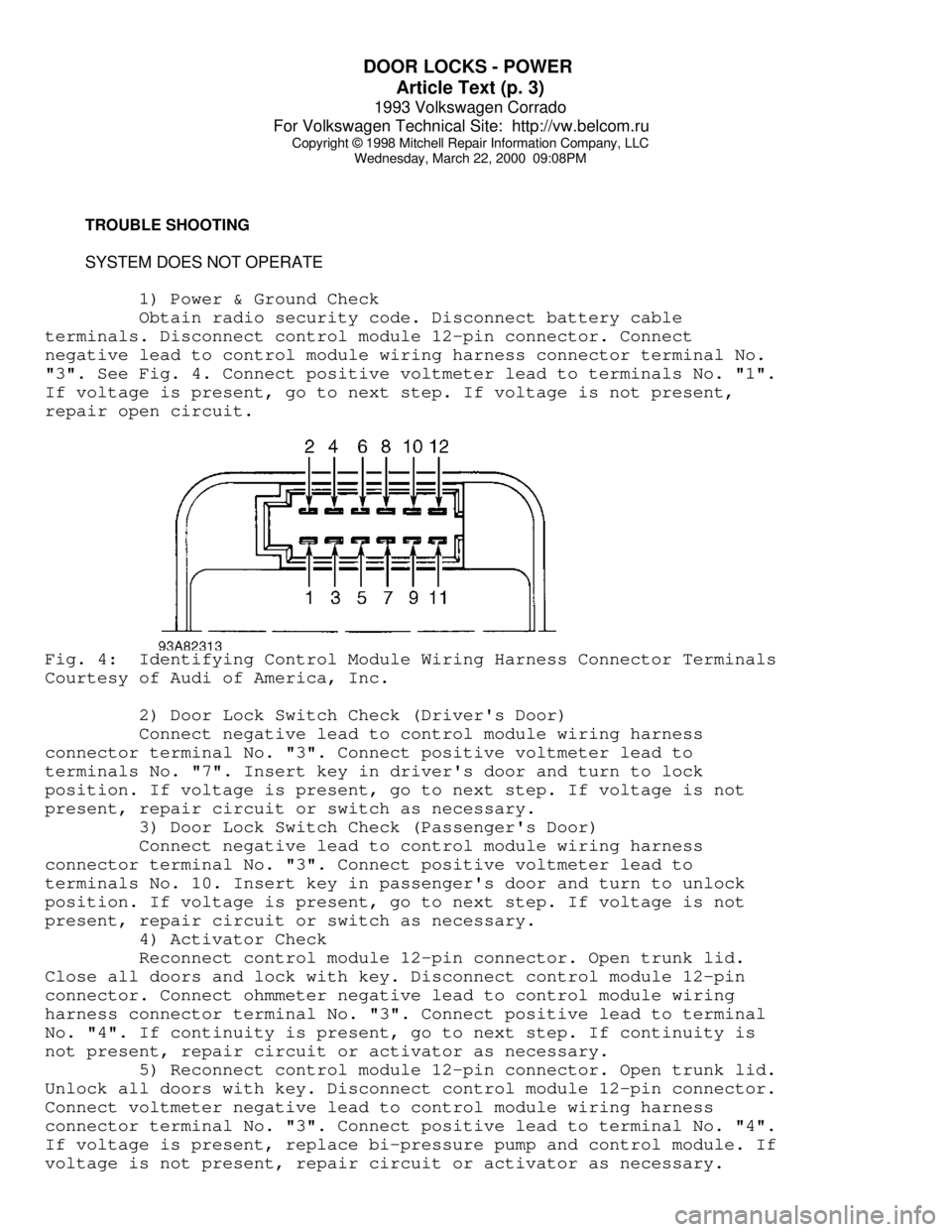
DOOR LOCKS - POWER
Article Text (p. 3)
1993 Volkswagen Corrado
For Volkswagen Technical Site: http://vw.belcom.ru
Copyright © 1998 Mitchell Repair Information Company, LLC
Wednesday, March 22, 2000 09:08PM
TROUBLE SHOOTING
SYSTEM DOES NOT OPERATE
1) Power & Ground Check
Obtain radio security code. Disconnect battery cable
terminals. Disconnect control module 12-pin connector. Connect
negative lead to control module wiring harness connector terminal No.
"3". See Fig. 4. Connect positive voltmeter lead to terminals No. "1".
If voltage is present, go to next step. If voltage is not present,
repair open circuit.Fig. 4: Identifying Control Module Wiring Harness Connector Terminals
Courtesy of Audi of America, Inc.
2) Door Lock Switch Check (Driver's Door)
Connect negative lead to control module wiring harness
connector terminal No. "3". Connect positive voltmeter lead to
terminals No. "7". Insert key in driver's door and turn to lock
position. If voltage is present, go to next step. If voltage is not
present, repair circuit or switch as necessary.
3) Door Lock Switch Check (Passenger's Door)
Connect negative lead to control module wiring harness
connector terminal No. "3". Connect positive voltmeter lead to
terminals No. 10. Insert key in passenger's door and turn to unlock
position. If voltage is present, go to next step. If voltage is not
present, repair circuit or switch as necessary.
4) Activator Check
Reconnect control module 12-pin connector. Open trunk lid.
Close all doors and lock with key. Disconnect control module 12-pin
connector. Connect ohmmeter negative lead to control module wiring
harness connector terminal No. "3". Connect positive lead to terminal
No. "4". If continuity is present, go to next step. If continuity is
not present, repair circuit or activator as necessary.
5) Reconnect control module 12-pin connector. Open trunk lid.
Unlock all doors with key. Disconnect control module 12-pin connector.
Connect voltmeter negative lead to control module wiring harness
connector terminal No. "3". Connect positive lead to terminal No. "4".
If voltage is present, replace bi-pressure pump and control module. If
voltage is not present, repair circuit or activator as necessary.
Page 502 of 920
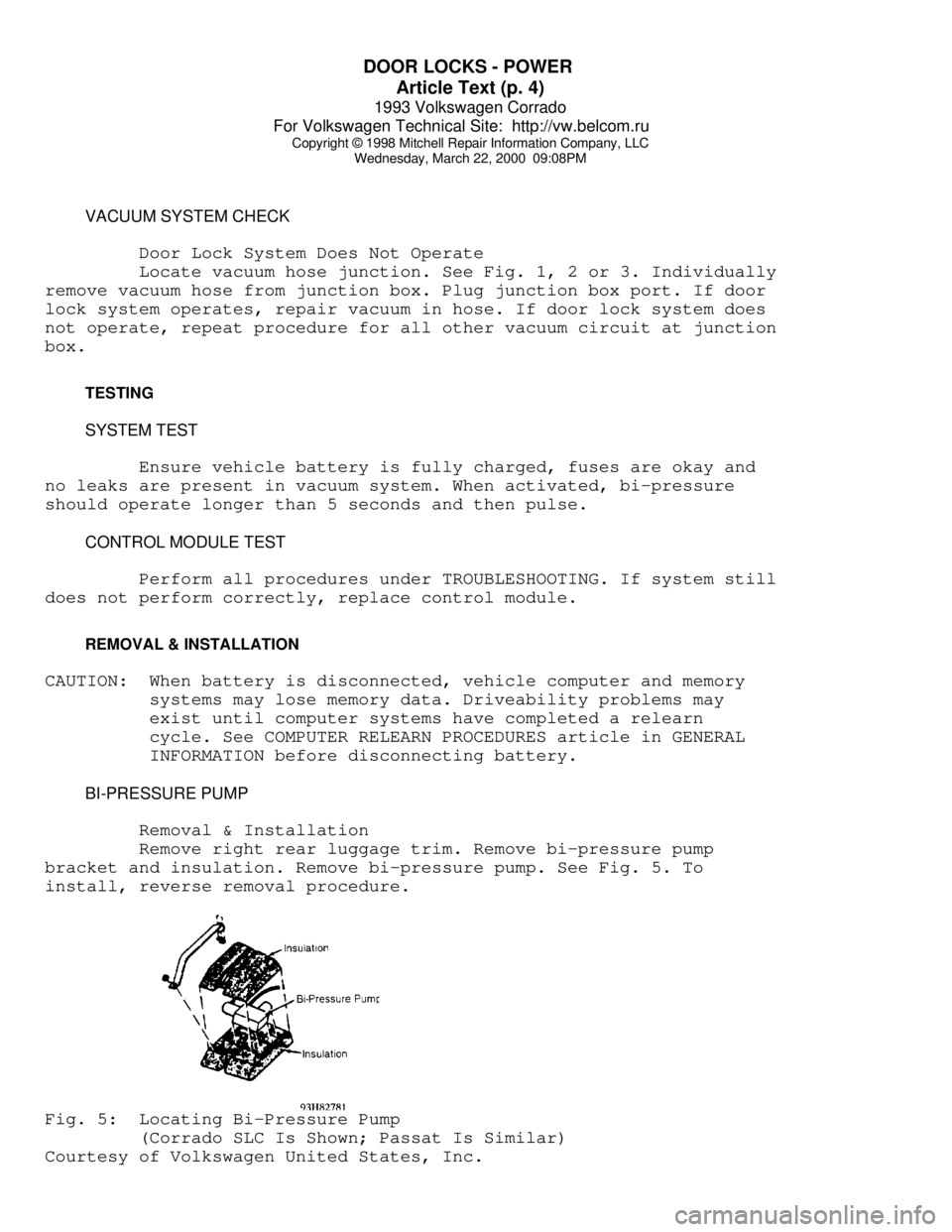
DOOR LOCKS - POWER
Article Text (p. 4)
1993 Volkswagen Corrado
For Volkswagen Technical Site: http://vw.belcom.ru
Copyright © 1998 Mitchell Repair Information Company, LLC
Wednesday, March 22, 2000 09:08PM
VACUUM SYSTEM CHECK
Door Lock System Does Not Operate
Locate vacuum hose junction. See Fig. 1, 2 or 3. Individually
remove vacuum hose from junction box. Plug junction box port. If door
lock system operates, repair vacuum in hose. If door lock system does
not operate, repeat procedure for all other vacuum circuit at junction
box.
TESTING
SYSTEM TEST
Ensure vehicle battery is fully charged, fuses are okay and
no leaks are present in vacuum system. When activated, bi-pressure
should operate longer than 5 seconds and then pulse.
CONTROL MODULE TEST
Perform all procedures under TROUBLESHOOTING. If system still
does not perform correctly, replace control module.
REMOVAL & INSTALLATION
CAUTION: When battery is disconnected, vehicle computer and memory
systems may lose memory data. Driveability problems may
exist until computer systems have completed a relearn
cycle. See COMPUTER RELEARN PROCEDURES article in GENERAL
INFORMATION before disconnecting battery.
BI-PRESSURE PUMP
Removal & Installation
Remove right rear luggage trim. Remove bi-pressure pump
bracket and insulation. Remove bi-pressure pump. See Fig. 5. To
install, reverse removal procedure.Fig. 5: Locating Bi-Pressure Pump
(Corrado SLC Is Shown; Passat Is Similar)
Courtesy of Volkswagen United States, Inc.
Page 503 of 920
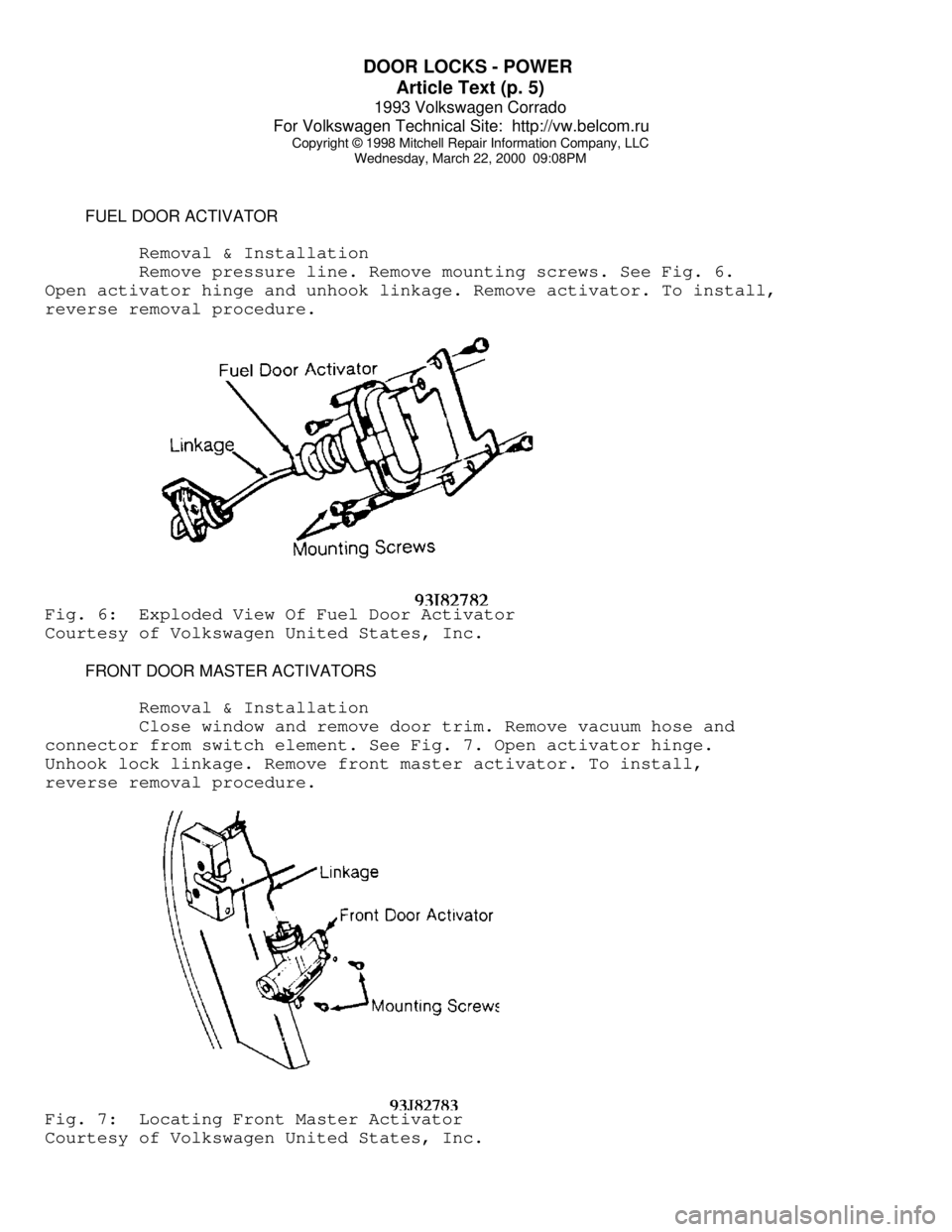
DOOR LOCKS - POWER
Article Text (p. 5)
1993 Volkswagen Corrado
For Volkswagen Technical Site: http://vw.belcom.ru
Copyright © 1998 Mitchell Repair Information Company, LLC
Wednesday, March 22, 2000 09:08PM
FUEL DOOR ACTIVATOR
Removal & Installation
Remove pressure line. Remove mounting screws. See Fig. 6.
Open activator hinge and unhook linkage. Remove activator. To install,
reverse removal procedure.Fig. 6: Exploded View Of Fuel Door Activator
Courtesy of Volkswagen United States, Inc.
FRONT DOOR MASTER ACTIVATORS
Removal & Installation
Close window and remove door trim. Remove vacuum hose and
connector from switch element. See Fig. 7. Open activator hinge.
Unhook lock linkage. Remove front master activator. To install,
reverse removal procedure.Fig. 7: Locating Front Master Activator
Courtesy of Volkswagen United States, Inc.
Page 504 of 920
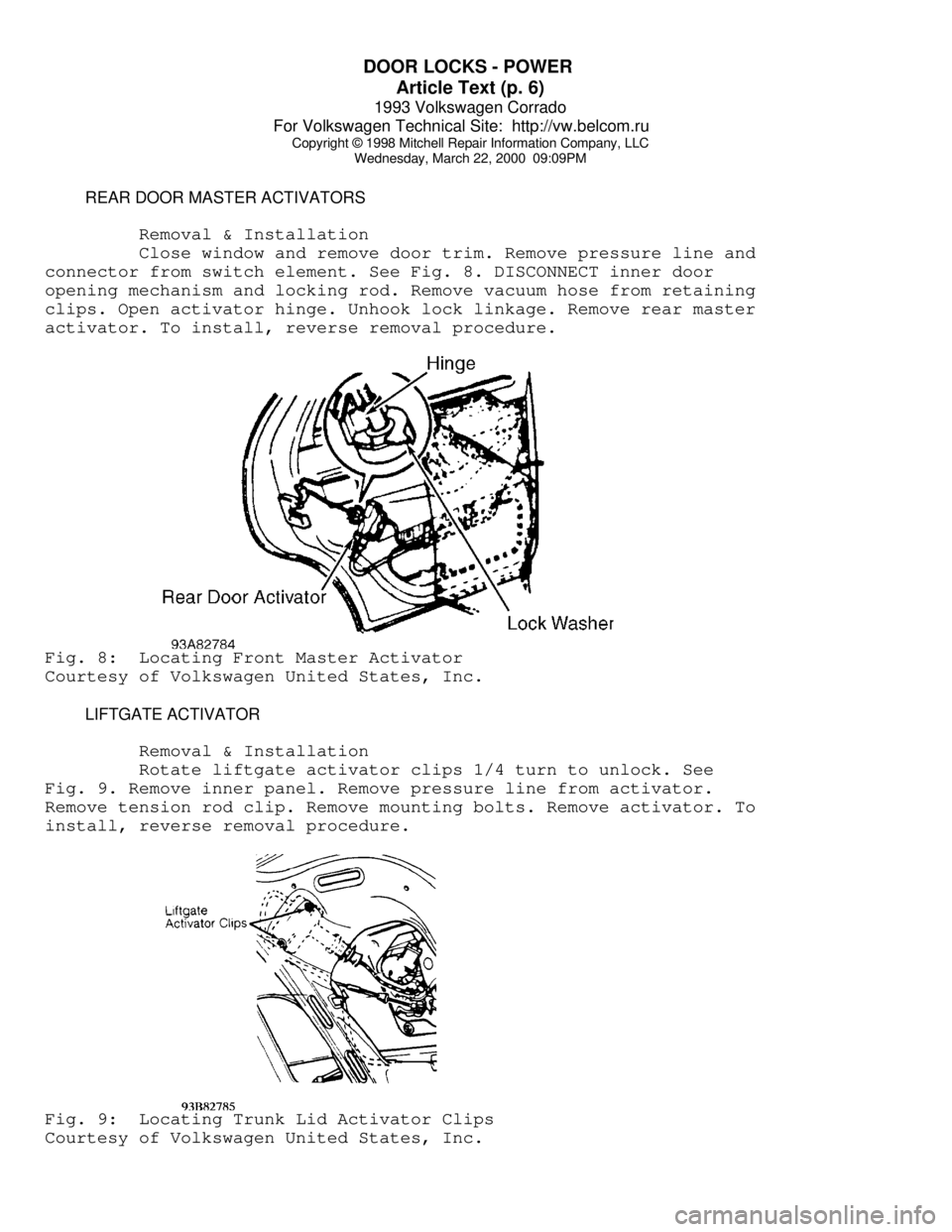
DOOR LOCKS - POWER
Article Text (p. 6)
1993 Volkswagen Corrado
For Volkswagen Technical Site: http://vw.belcom.ru
Copyright © 1998 Mitchell Repair Information Company, LLC
Wednesday, March 22, 2000 09:09PM
REAR DOOR MASTER ACTIVATORS
Removal & Installation
Close window and remove door trim. Remove pressure line and
connector from switch element. See Fig. 8. DISCONNECT inner door
opening mechanism and locking rod. Remove vacuum hose from retaining
clips. Open activator hinge. Unhook lock linkage. Remove rear master
activator. To install, reverse removal procedure.Fig. 8: Locating Front Master Activator
Courtesy of Volkswagen United States, Inc.
LIFTGATE ACTIVATOR
Removal & Installation
Rotate liftgate activator clips 1/4 turn to unlock. See
Fig. 9. Remove inner panel. Remove pressure line from activator.
Remove tension rod clip. Remove mounting bolts. Remove activator. To
install, reverse removal procedure.Fig. 9: Locating Trunk Lid Activator Clips
Courtesy of Volkswagen United States, Inc.
Page 505 of 920

DOOR LOCKS - POWER
Article Text (p. 7)
1993 Volkswagen Corrado
For Volkswagen Technical Site: http://vw.belcom.ru
Copyright © 1998 Mitchell Repair Information Company, LLC
Wednesday, March 22, 2000 09:09PM
WIRING DIAGRAMS
See appropriate chassis wiring diagram in WIRING DIAGRAMS.
END OF ARTICLE
Page 506 of 920

E - THEORY/OPERATION
Article Text
1993 Volkswagen Corrado
For Volkswagen Technical Site: http://vw.belcom.ru
Copyright © 1998 Mitchell Repair Information Company, LLC
Wednesday, March 22, 2000 09:09PM
ARTICLE BEGINNING
1993 ENGINE PERFORMANCE
Volkswagen Theory & Operation - Motronic
Corrado SLC
INTRODUCTION
This article covers basic description and operation of engine
performance-related systems and components. Read this article before
diagnosing vehicles or systems with which you are not completely
familiar.
COMPUTERIZED ENGINE CONTROLS
ELECTRONIC CONTROL UNIT
The Motronic engine management system uses a single
Electronic Control Module (ECM) for fuel injection, idle speed
control, ignition, and emission controls. The Electronic Control
Module (ECM) continually corrects air/fuel mixture based on signals
from various signals. The ECM is located underneath center of
windshield cowl, directly behind engine compartment firewall.
NOTE: Components are grouped into 2 categories. The first category
covers INPUT DEVICES, which control or produce voltage
signals monitored by the control unit. The second category
covers OUTPUT SIGNALS, which are components controlled by
the control unit.
INPUT DEVICES
Engine Coolant Temperature (ECT) Sensor
Sensor is located on thermostat housing. As engine coolant
temperature increases, the resistance of the sensor decreases. Engine
coolant temperature sensor signals are used for control of ignition
timing, injector pulse width, and idle speed stabilization. In
addition, knock sensors, idle speed control, oxygen sensor and fuel
tank venting are activated based on coolant temperature.
Engine Speed (RPM)/Reference Sensor
Engine speed (RPM) and crankshaft position are registered by
a single sensor located on side of engine block. The sensor reads a
toothed wheel mounted on the crankshaft. The wheel has a 2-tooth gap
which is used as a reference point for crankshaft position. The engine
speed/reference signal is used to monitor engine RPM and to identify
TDC position of cylinder No. 1.
Hall Effect Sensor
See ELECTRONIC IGNITION SYSTEM under IGNITION SYSTEM in this
Page 507 of 920
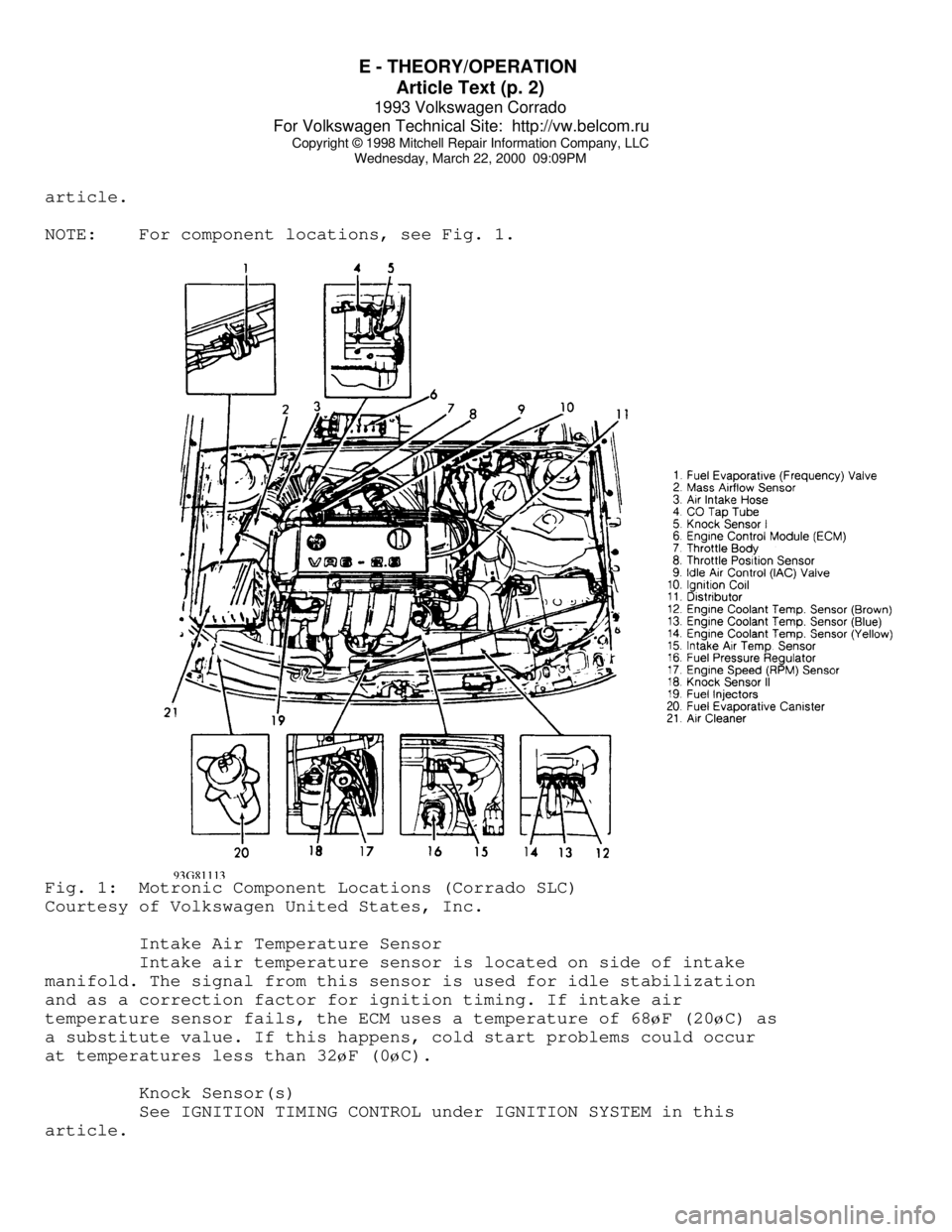
E - THEORY/OPERATION
Article Text (p. 2)
1993 Volkswagen Corrado
For Volkswagen Technical Site: http://vw.belcom.ru
Copyright © 1998 Mitchell Repair Information Company, LLC
Wednesday, March 22, 2000 09:09PM
article.
NOTE: For component locations, see Fig. 1.Fig. 1: Motronic Component Locations (Corrado SLC)
Courtesy of Volkswagen United States, Inc.
Intake Air Temperature Sensor
Intake air temperature sensor is located on side of intake
manifold. The signal from this sensor is used for idle stabilization
and as a correction factor for ignition timing. If intake air
temperature sensor fails, the ECM uses a temperature of 68øF (20øC) as
a substitute value. If this happens, cold start problems could occur
at temperatures less than 32
øF (0øC).
Knock Sensor(s)
See IGNITION TIMING CONTROL under IGNITION SYSTEM in this
article.
Page 508 of 920

E - THEORY/OPERATION
Article Text (p. 3)
1993 Volkswagen Corrado
For Volkswagen Technical Site: http://vw.belcom.ru
Copyright © 1998 Mitchell Repair Information Company, LLC
Wednesday, March 22, 2000 09:09PM
Mass Airflow Sensor
A hot-wire air mass sensor is used to measure airflow into
the engine. The sensor is attached to air filter housing. The hot-wire
in sensor is kept at 356øF (180øC) above air temperature.
As airflow increases, the wire is cooled and the resistance
of the sensor changes. The resulting current change is converted to a
voltage signal and is used by the ECM to calculate the volume of air
taken in.
If a fault develops with mass airflow sensor signal, the
signal from throttle valve potentiometer is used as a substitute in
order for the car to be driveable.
Throttle Valve Potentiometer
Throttle valve potentiometer (throttle position sensor) is
connected to throttle valve shaft. It informs the ECM about the power
requested by the driver (throttle opening). Idle and full throttle
switches are NOT used in potentiometer. Idle speed and full throttle
applications are recognized by the ECM from the voltage output of the
potentiometer.
Throttle valve potentiometer signals are used for idle speed
stabilization, idle air volume control, fuel after-run shut-off, and
full throttle enrichment. The ECM uses mass airflow sensor signal and
engine RPM signals as substitute values if the potentiometer fails.
NOTE: On automatic transmission equipped vehicles, the throttle
valve potentiometer is combined in the housing with the
potentiometer for transmission control.
Oxygen (O2) Sensor
The heated oxygen sensor is made from zirconium dioxide,
while the inner and outer surfaces are coated with platinum. If fuel
mixture is lean (excess oxygen), the oxygen sensor will send a low
voltage signal (about 100 millivolts) to the ECM. If fuel mixture is
rich (lack of oxygen), the oxygen sensor will send a high voltage
signal (about 900 millivolts) to the ECM.
OUTPUT SIGNALS
NOTE: Vehicles are equipped with different combinations of
computer-controlled components. Not all components listed
below are used on every vehicle. For theory and operation on
each output component, refer to the system indicated after
component.
EGR Frequency Valve
See EXHAUST GAS RECIRCULATION (EGR) SYSTEM under EMISSION
SYSTEMS in this article.
Fuel Evaporative (Frequency) Valve
See FUEL EVAPORATIVE EMISSIONS SYSTEM under EMISSION SYSTEMS
in this article.
Page 509 of 920

E - THEORY/OPERATION
Article Text (p. 4)
1993 Volkswagen Corrado
For Volkswagen Technical Site: http://vw.belcom.ru
Copyright © 1998 Mitchell Repair Information Company, LLC
Wednesday, March 22, 2000 09:09PM
Fuel Injectors
See FUEL CONTROL under FUEL SYSTEM in this article.
Fuel Pump
See FUEL DELIVERY under FUEL SYSTEM in this article.
Idle Air Control/Stabilizer Valve
See IDLE SPEED under FUEL SYSTEM in this article.
Ignition Coil & Output Stage
See DISTRIBUTORLESS IGNITION SYSTEM (DIS) under IGNITION
SYSTEM in this article.
Malfunction Indicator (CHECK ENGINE) Light
See MALFUNCTION INDICATOR (CHECK ENGINE) LIGHT under SELF-
DIAGNOSTIC SYSTEM in this article.
FUEL SYSTEM
FUEL DELIVERY
Fuel Pump
A 2-stage fuel pump, located in fuel tank, is used (one motor
drives two separate pumps). The stage one vane-type pump draws fuel,
through a screen, from bottom of fuel tank and into an accumulator.
The vane-type pump acts as a transfer pump. The stage two gear-type
pump draws fuel from bottom of accumulator and out fuel lines.
Fuel Pressure Regulator
The diaphragm-type fuel pressure regulator is attached to
fuel return side of fuel rail. Fuel pressure is regulated depending on
intake manifold pressure. As intake manifold pressure changes, the
pressure regulator will increase or decrease fuel system pressure.
FUEL CONTROL
Fuel Injectors
Fuel injectors are supplied with battery (system) voltage
through power supply relay and are controlled (grounded) by the ECM.
Injectors are opened sequentially in cylinder firing order. Fuel
quantity is determined by injector on time (duty cycle).
IDLE SPEED
Idle Air Control/Stabilizer Valve
The idle air control/stabilizer valve is actuated by the ECM
thorough the valve's ground control circuit. When a defect in circuit
is recognized, both output stages are shut-off and the valve rotates
to a fixed potion. This permits engine to idle at a warm engine idle
speed.
IGNITION SYSTEM
Page 510 of 920

E - THEORY/OPERATION
Article Text (p. 5)
1993 Volkswagen Corrado
For Volkswagen Technical Site: http://vw.belcom.ru
Copyright © 1998 Mitchell Repair Information Company, LLC
Wednesday, March 22, 2000 09:09PM
NOTE: Corrado SLC models are equipped with a Distributorless
Ignition System (DIS).
ELECTRONIC IGNITION SYSTEM
The electronic ignition system consists of ECM, power output
stage, ignition coil, distributor, mass airflow sensor, throttle valve
potentiometer, engine coolant temperature sensor, and Hall Effect
sensor.
Ignition system uses engine speed, engine load, and throttle
valve potentiometer signals to calculate ignition timing. Engine
coolant temperature signal is used to correct ignition timing when
engine is cold and to activate knock sensor circuit. See KNOCK
SENSOR(S) under IGNITION TIMING CONTROL in this article.
Hall Effect Sensor
On Corrado SLC, this sensor is mounted on end of camshaft
(near ignition coil). Sensor consists of a magnetic enclosure and
integrated semi-conductor circuit. A voltage signal is generated when
trigger wheel, turning at camshaft speed, interrupts magnetic field
created by the semi-conductor. Hall Effect sensor and engine
speed/reference signals are used to identify TDC position of cylinder
No. 1 for sequential fuel injection and spark knock regulation.
DISTRIBUTORLESS IGNITION SYSTEM (DIS)
Hall Effect Sensor
See HALL EFFECT SENSOR under ELECTRONIC IGNITION SYSTEM in
this article.
Ignition Coil & Output Stage
The distributorless (direct) ignition system consists of ECM,
power output stage, 3 double-ended ignition coils and secondary
ignition wires. The ECM operates each ignition coil through the power
output stage. The power output stage and heat sink are located behind
ignition coils. The ignition coils are located on left side of
cylinder head. When the power output stage fires an ignition coil, a
spark is supplied to 2 spark plugs at one time. One spark plug fires
during the compression stroke, and the other spark plug fires during
the exhaust stroke (waste spark).
IGNITION TIMING CONTROL
Knock Sensor(s)
The knock sensor(s) work(s) like a microphone to "listen" for
spark knock (detonation). When detonation occurs, ignition timing is
retarded until the knock is eliminated.
On Corrado SLC, 2 knock sensors are mounted on side of engine
block. Knock sensor I monitors cylinders No. 1, 3 and 5. Knock sensor
II monitors cylinders No. 2, 4 and 6.